Potatoes are incredibly versatile and I love all of their many forms. From tater tots, to baked potatoes, to casseroles, you just can’t go wrong when using potatoes as your main ingredient. Boiling potatoes is an essential cooking skill to master if you’re hoping to perfect your potato game.
Let’s uncover the best tips and tricks for perfectly boiled potatoes.
This post is part of our Basic Cooking Skills series. Each week we will be doing a deep-dive into one basic cooking skill and a brand new recipe to accompany it to practice that newfound skill. Check back throughout the series for updates and new posts.
Please note this post contains affiliate links, which means I receive a small commission, at no extra cost to you, if you make a purchase using the links. Please see my disclosure for more details.
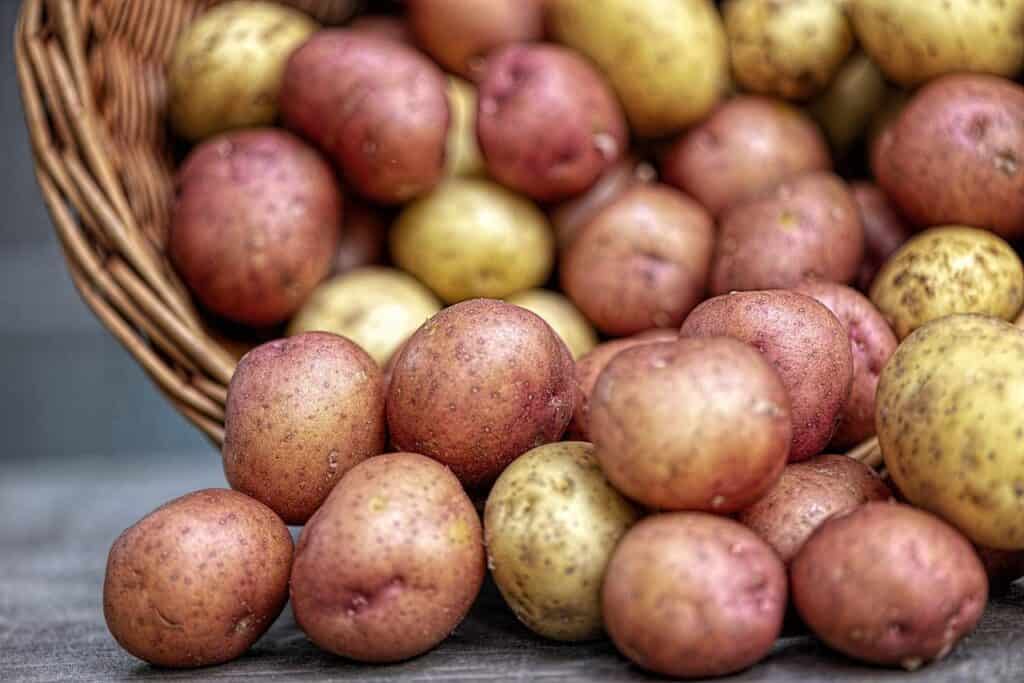
What is the purpose of boiling potatoes?
I love potatoes.
Lately I’ve been really into sweet potatoes and cannot eat enough sweet potato fries.
No boiling is needed in that recipe, but I’ve recently learned how boiling potatoes is not only perfect for mashed potatoes, but is a great first step to take before finishing off the potatoes using another method (such as pan-frying or roasting).
Boiling potatoes preserves the liquid within the potato and absorbs some of the surrounding water, compared to roasting in an oven which dries them out.
The texture grows softer with increased time in the boiling water, eventually becoming soft enough to easily mash.
Boiling potatoes can be used as a means to parboil the potatoes. Parboiling potatoes before roasting or pan-frying them radically decreases their cooking time and in my opinion, makes them a lot easier to prepare to my liking. For example, when pan-frying I can just focus on crisping them up and don’t have to be concerned about them being undercooked on the inside.
how to: boil potatoes perfectly ever time
- Clean potatoes thoroughly with a brush to remove any dirt.
- In a large pot, place the potatoes and cover with water. Season the water generously. (Adding just a tsp or salt really doesn’t do much at all — for more info check out 4 Elements of Cooking)
- Bring the water to a boil. Reduce the heat and cook until the potatoes can be easily pierced with a fork, about 20-25 minutes.
- Drain using a colander. **Pro tip: run cool water from your faucet when draining the hot water to go easy on your kitchen pipes.
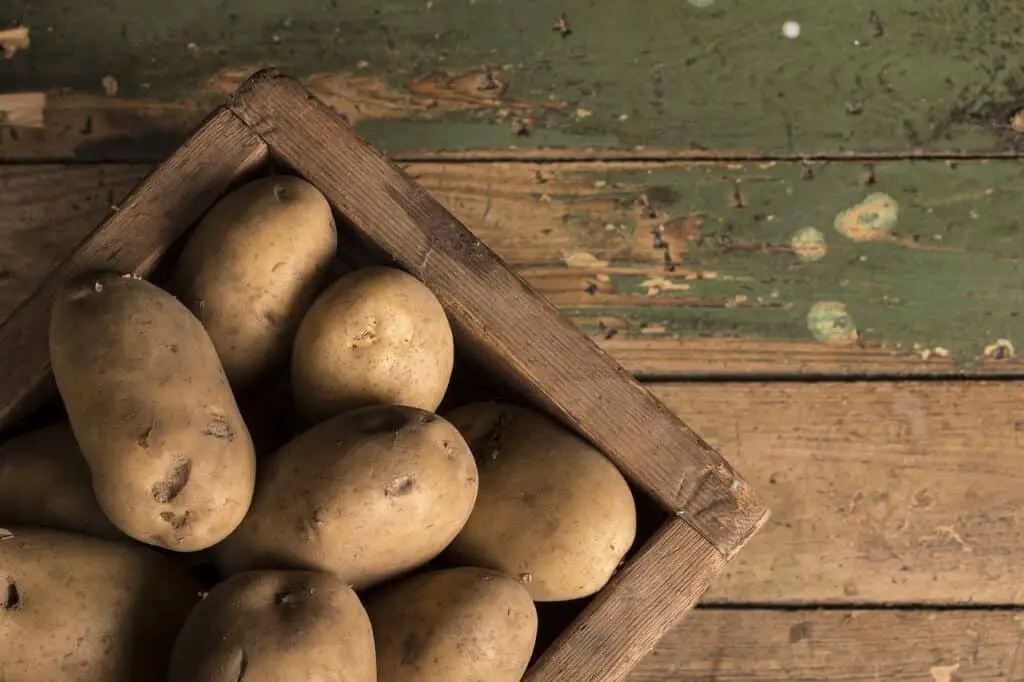
Guide to Boiling Potatoes
Materials Needed for boiling potatoes
Which Potatoes are Best for boiling
While all potatoes can be boiled, some just tend to work better than others.
Starchy Russets or Yukon Golds– these boil best whole and are more likely to fall apart if cut. They mash really easily to form light and fluffy mashed potatoes and are the classics in my mind.
Waxy Red – Small red potatoes are recent favorites of mine If you’re a fan of potato skin, their flesh is much firmer and provide great pops of color. Reds tend to hold their shape fairly well so be careful when mashing! If mashed too much they can form a thick pasty texture.
Sweet potatoes – Sweet potatoes are rich with vitamins and nutrients from beta-carotene or anthocyanins. Boiling sweet potatoes preserves these nutrients better when compared to baking or pan-frying. Keeping the skin on sweet potatoes when boiling helps retain their high nutrient content, but even halving them with the skins on can greatly reduce the cooking time.
Preparing Potatoes for boiling
To peel or not to peel?
- Peeling potatoes before or after boiling does not really have much effect on the preparation of the potatoes and is really up to your personal preference.
- Keep in mind, potato skins are filled with nutrients and are easily the healthiest part of each spud, aiding digestion, the management of blood pressure, and more. Peeling potatoes removes all those nutritional goodies your body could benefit from otherwise!
- In my opinion, I love the added texture of potato skins in mashed potatoes as they help break up what could otherwise be a lot of soft, mushy bites.
- If you’re going to forego the potato skin, peeling potatoes after they are boiled is a much easier task than peeling beforehand.
To cut or not to cut?
- Cutting the potatoes into smaller pieces can reduce the cooking time greatly when using large potatoes. This is a quick way to cut the time down and doesn’t affect the quality or taste.
- If you decide to cut the potatoes, the pieces should be as equally sized as possible for even cooking.
Flavorful Additions
Lots of ingredients can be added when boiling potatoes to enhance the overall flavor. Some of the most common additions are:
- Broth (instead of, or in addition to, water)
- Garlic
- Butter
- Onion
- Black pepper
- Fresh herbs
Pin me!

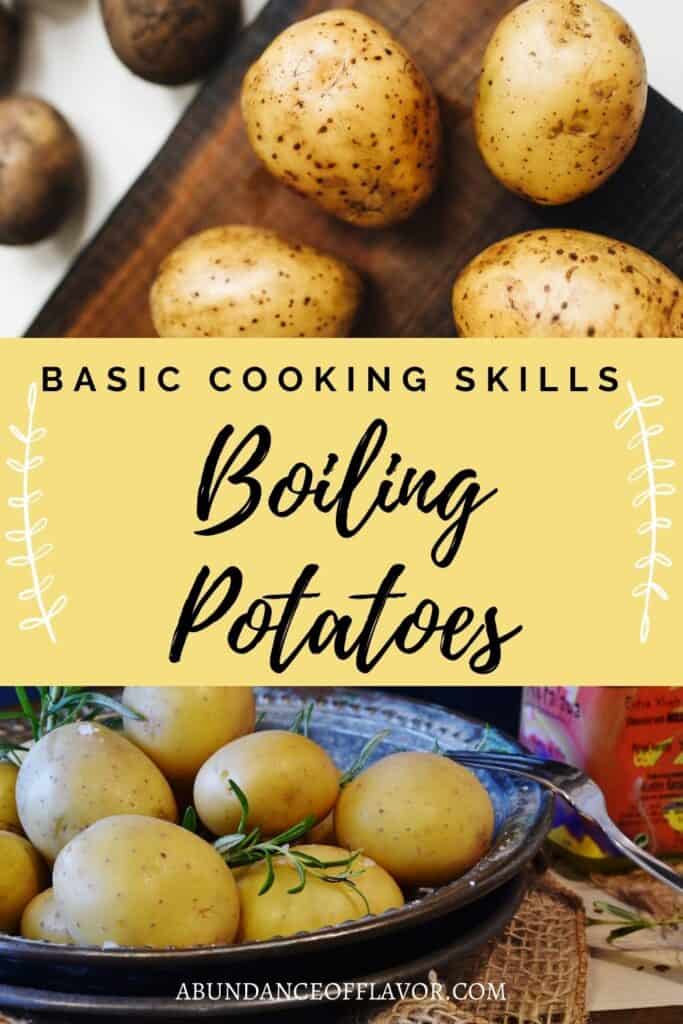
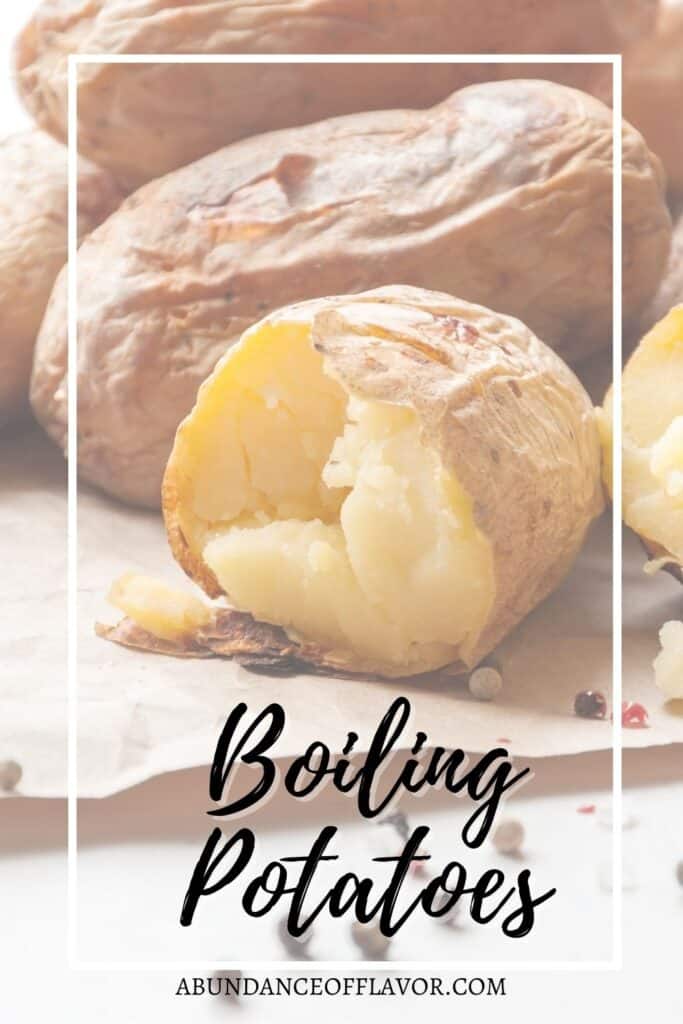
Implement Your New Skill
This Thursday we’ll have a new recipe up on the blog for you to try out your new skill. Check back and try it out!
What’s your favorite form of potato?? Mine HAS to be tater tots!! Gimme all the tots all the time. Share yours in the comments below and we can all gush over our love of these yummy starches.



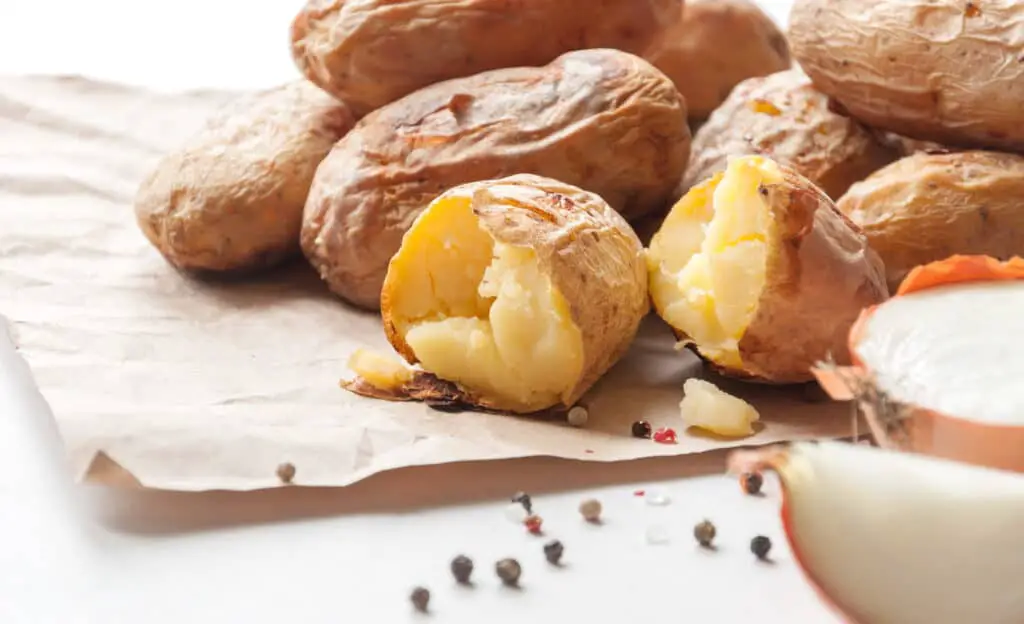
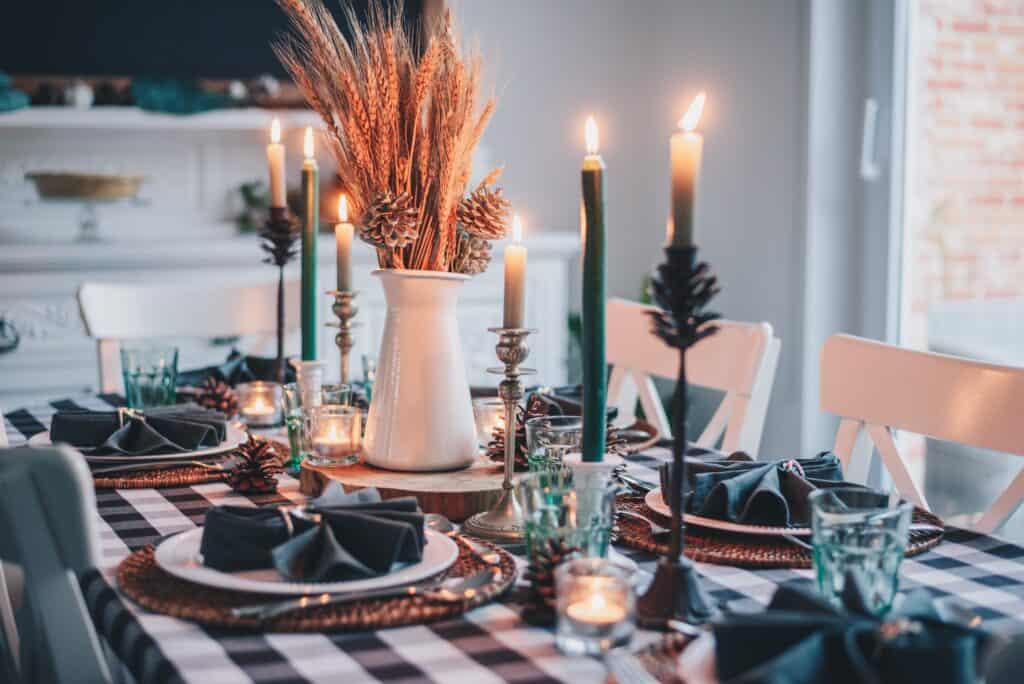
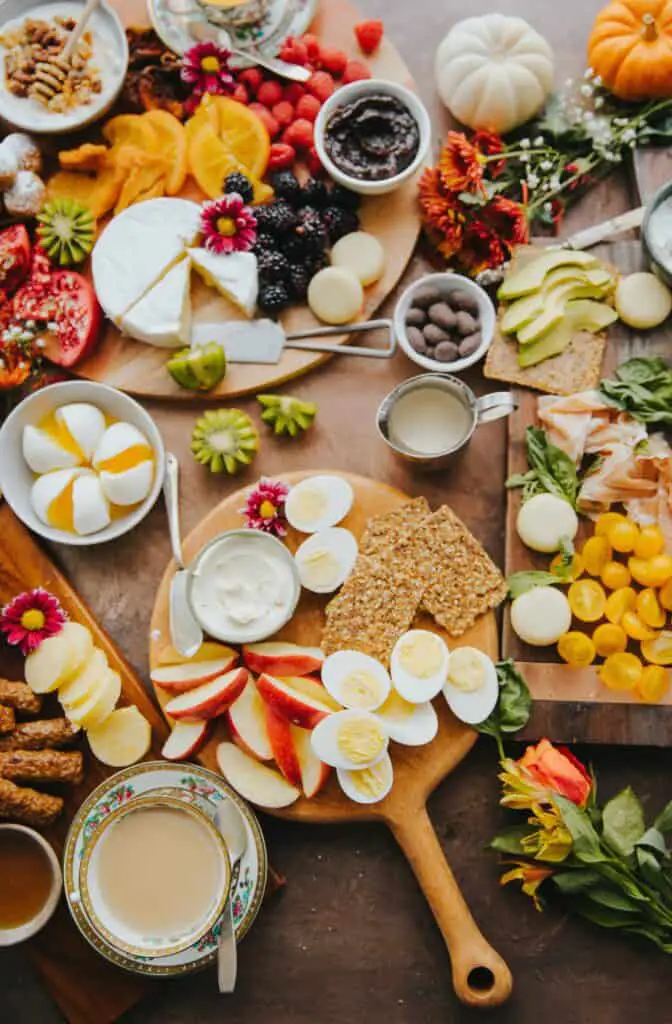

I have to admit. I’m not a huge potato fan except with a nice Sunday night dinner. Now sweet potatoes are a whole other issue – I can’t get enough. There’s nothing like a plump sweet potato (done as a baked potato) or Well cooked sweet potato fries. Thanks for sharing,
Sweet potatoes are my favorite too! I can’t get enough of them
Great article on potatoes, a rare piece on potatoes. We love potatoes as a family and I am sure the tips here are great.
Thanks so much for reading!
I love Japanese sweet potatoes they are the best also for regular I like a lot with herbs and spices. Thanks for this it will help me better cooking potatoes
I don’t think I’ve ever had Japanese sweet potatoes but I am so intrigued!
I love potatoes! They are delicious. Thank you for sharing this recipe with me.
Thank you for reading!
Thank you so much for sharing this!! I am doing Thanksgiving this year and this helps so much with my potatoes!
Yay I’m so glad it could be helpful!
I am basically a potato — I love them. Thanks for sharing!
Haha I feel the same!!
Although roast potatoes are my favourite, boiled potatoes taste lovely with herbs on them! I’m a sucker for sweet potatoes too!
I love herby white potatoes but my faves are sweet potatoes with just a little bit of brown sugar!
Boiled potatoes were such a signature dish in any Dutch meal (so it was at my house) and I loved them, especially with some herbs or a splash of mayonnaise! Thank you for reminding me how delicious they can be cooked like this!
I’ve never used mayo before but that sounds like such a great idea!
Potatoes are a great addition to any meal, mashed, roasted, jacket potatoes, boiled, cold in a salad they are just yum. Some fab tips 👍🏻
Thanks so much! I love potatoes all of those ways
Yum! I always love boiling potatoes for mashed potatoes or scalloped potatoes. So yummy!
I’ve never made scalloped potatoes myself before but will have to try soon!
I LOVE potatoes, there are so many ways you can cook them! Thank you for sharing this post, I’m never sure how long to boil potatoes or whether to cut them before or after!
I hope it was helpful! Thanks for reading
Roast potatoes are my favourites but I do parboil them first then shake them to fluff them up for crispy edges. I don’t add salt though so I’ll try that next time and see what the difference is 🙂
Oh that sounds like a great tip I’ll have to try!
Fun post! A good resource for those that have limited experience in preparing potatoes. I love Yukon Gold! Thanks for sharing.
Thanks so much, I appreciate it!
It always amazes me how people some how have skipped the basic cooking skills class in school. I recently learned how to boil a hard boiled egg the correct way. I never did it wrong before but it definitely streamlined the process for me. Thanks for the potato advice! I’ll be sure to use it this week when I cook some up for the family.
Aww that’s so great to hear! I had to learn most of this myself too, I wish I would have learned in school!
What a perfect guide full of details, looks so simple and
delicious..
Thank you so much!
I love how versatile potatoes are. Boiled potatoes with a generous helping of butter are my favourite.
Such a classic recipe!
I love this practical advice! I was not taught to cook growing up, so had to make things up as I went along when I moved out. This is such a helpful series!
My favourite way to eat potatoes is roasted and seasoned. I actually only learned how to roast potatoes in the last year!
I’m so glad to hear it! In the past year I’ve really learned to love roasted veggies of all kinds 🙂
Great post and handy tips. Potatoes are my favourite veggie because they are so versatile. Even a simple boiled potato is delicious to me.
I totally agree! Thanks for reading!
Hubby loves potatoes, so thanks for the tips.
Thank you for reading!
I never thought about adding flavors to the boiling water! Great tips! Thanks!
I’m glad it was helpful! Thank you!
Potatoes taste delicious with tomato ketchup. 😉 Great article for all beginners. Thanks for sharing this.
Ahh I love fried potatoes in ketchup, SO good!
Pingback: Creamy Garlic Parmesan Mashed Potatoes - Abundance of Flavor
Potatoes are one of the best food items because you can do so much with them, but they’re also something I shouldn’t ready eat because decide they’re fast acting carbs and I have reactive hypoglycaemia. Still, it’s good to know how to cook them properly for others
Oh wow that’s so interesting. Do you know if it’s the same for sweet potatoes? I know the starch content of white potatoes are much higher. Thanks for giving this a read!
Oh, thank you so much for this! Honestly, I’m so bad at cooking so all of your tips on how to boil potato perfectly is so helpful for me ^^
Aww that’s so great to hear, thanks for reading!
Thanks for sharing your tips, I like to boil a kettle of water, then put that in the saucepan or pot, then bring it back up the boil and then put in the potatoes in, it saves me time waiting for cold water to come up the boil if I’m time tight 🙂
Nic | Nic’s Adventures & Bakes
Nice! I’ve never used a kettle before but it sounds like they boil water sooo quickly
Pingback: How to Bake a Potato in the Oven - Basic Cooking Skills - Abundance of Flavor
Pingback: 21 Basic Cooking Skills for Beginners - Abundance of Flavor